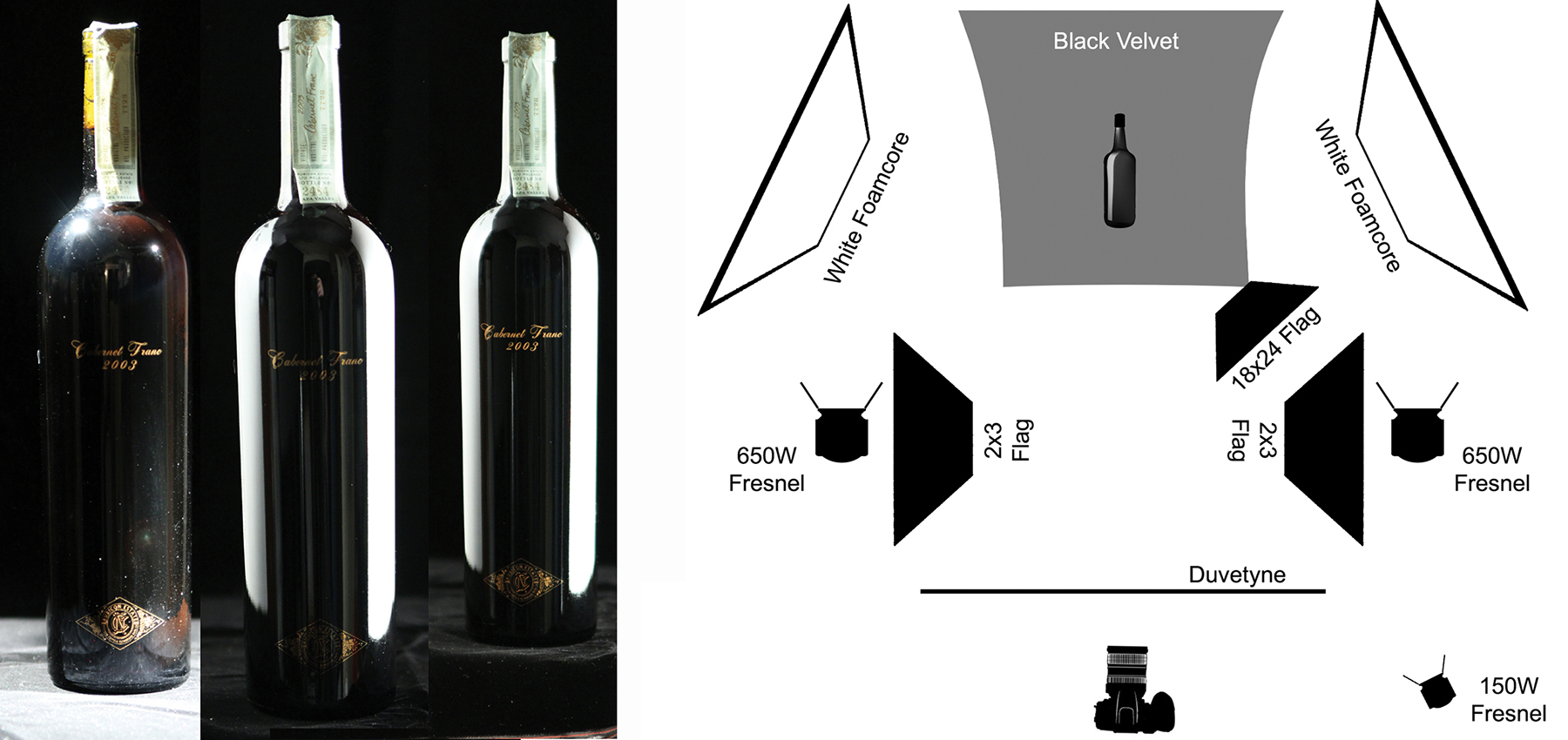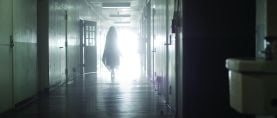
Using Specular Reflections
Take a look at magazine advertisements for cars, jewelry, drinks, silverware, even electronics, and you’ll notice that they employ specular highlights to show off the products’ “beauty.”
Instead of eliminating reflections via a polarizer, sometimes you want to use them to your advantage, creating specular highlights with your lighting. A specular highlight is a mirror reflection of a light source in your subject; this can also be described as a direct reflection. In many cases, a specular highlight is an unwanted reflection of a light source: the sun, a small point source, etc. However, properly utilized, specular reflections of large light sources help to define the shape of a glossy or highly reflective surface, such as glass or chrome.
A classic example of this is a wine bottle — say, for instance, this beautiful bottle of Francis Ford Coppola’s Rubicon Cabernet Franc from 2003 (seen at top on far left). To light the dark bottle, I’m going to use two Arri 650-watt Fresnel lamps. If I use the lamps clean, we’ll see the lamps reflected as individual points of light in the dark glass. It’s not a pleasing look, and it doesn’t help to define the shape of the bottle. Yes, we’re getting an exposure, but we’re not doing this beautiful, simple bottle any favors by just pumping hard light onto it.
Instead, we need to increase the size of the light sources so that they become large enough to reflect down the entire length of the bottle. In this case, I’m going to bounce the Fresnels into two large sheets of white foamcore. By evenly filling the foamcore with light from the 650-watt Fresnels, I turn a 6" pinpoint of light into a 40"x60" source. Now what we’re seeing in the bottle is the mirror-reflection of the large sheets of foamcore, which helps reveal the shape of the bottle and is much more pleasing to the eye than the two lone points of light.
This is using specular reflections to our advantage.
Now, achieving the desired result is a bit more complicated than simply bringing in two large sheets of foamcore. For all intents and purposes, the entire bottle is a mirror. Therefore, I had to build up a lot of black all around the bottle so as to not reflect either myself or any part of the room in which I was shooting. Working with duvetyn hanging from C-stands, I surrounded the bottle with black; the bottle reflected that black, giving the glass an overall smooth and clean appearance.
I also had to put up ‘siders’ — solid black flags — on the sides of the Fresnels to keep the fixtures themselves from being reflected in the glass. For these siders, I simply used 24"x36" cuts of black foamcore on C-stands.
The camera and I were also reflected in the bottle. To remedy that, I hung large pieces of duvetyn in front of the camera and cut out a small hole through which I could fit the lens. This erased my reflection — as well as that of the room behind me — from the face of the bottle.
Finally, I wanted to shoot this as if the photo would be used for an advertisement, meaning the name on the bottle was very important. Bringing out those gold letters against the dark glass was no easy task. I used a 150-watt Arri Fresnel positioned very high, pointed down at the bottle, and spotted in on the gold letters. I then brought in another black foamcore flag — as close to the bottle as possible without it being in the frame — and used that to cut the specular reflection of the 150-watt lamp off of the bottle’s upper curve.
This principle of using specular highlights applies to photographing any glossy or reflective surface. In car photography, for example, we follow the same concept, using very large light sources or bounces — typically 20'x40', or even larger — to create appropriately large reflections across the surface of the car.
Any light source can produce a specular reflection in a glossy or reflective surface. The larger the source, the more it will help to define the shape of the surface. Foamcore makes for an excellent source as it has no texture and will therefore appear as a smooth highlight. You can use any light-colored material to create a specular highlight, but be careful: If your material has any pattern or texture to it, you might be able to see it in the reflection on the subject. For instance, I could have used a soft box to create the specular highlight on the wine bottle, but any wrinkles in the front diffusion of the box would have been visible in the highlight.
When working with specular highlights, it’s handy to remember the law of reflection, whereby the angle of incidence is equal to the angle of reflection. This means that the precise angle at which light strikes a glassy or glossy surface is equal to the angle at which the light is then reflected in the opposite direction.
Take a look at magazine advertisements for cars, jewelry, drinks, silverware, even electronics, and you’ll notice that they employ specular highlights to show off the products’ “beauty.” Studying these ads and then breaking down how you think they were lit is a great way to expand your knowledge and experience without requiring access to the lights and products themselves.



